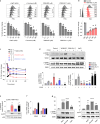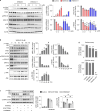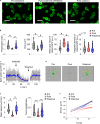Inhibition of WNK Kinases in NK Cells Disrupts Cellular Osmoregulation and Control of Tumor Metastasis
- PMID: 39265537
- PMCID: PMC11521464
- DOI: 10.1159/000540744
Inhibition of WNK Kinases in NK Cells Disrupts Cellular Osmoregulation and Control of Tumor Metastasis
Abstract
Introduction: The serine/threonine with-no-lysine (WNK) kinase family function in blood pressure control, electrolyte homeostasis, and cellular osmoregulation. These kinases and their downstream effectors are considered promising therapeutic targets in hypertension and stroke. However, the role of WNK kinases in immune cells remains poorly understood.
Methods: Using the small-molecule WNK kinase inhibitors WNK463 and WNK-IN-11, we investigated how WNK kinase inhibition affects natural killer (NK) cell physiology.
Results: WNK kinase inhibition with WNK463 or WNK-IN-11 significantly decreased IL-2-activated NK cell volume, motility, and cytolytic activity. Treatment of NK cells with these inhibitors induced autophagy by activating AMPK and inhibiting mTOR signaling. Moreover, WNK kinase inhibition increased phosphorylation of Akt and c-Myc by misaligning activity of activating kinases and inhibitory phosphatases. Treatment of tumor-bearing mice with WNK463 impaired tumor metastasis control by adoptively transferred NK cells.
Conclusion: The catalytic activity of WNK kinases has a critical role of multiple aspects of NK cell physiology and their pharmacologic inhibition negatively impacts NK cell function.
Keywords: Autophagy; Cytotoxicity; Natural killer; Osmoregulation; WNK kinases.
© 2024 The Author(s). Published by S. Karger AG, Basel.
Conflict of interest statement
The authors declare that the research was conducted in the absence of any commercial or financial relationships that could be construed as a potential conflict of interest. The content is solely the responsibility of the authors and does not necessarily represent the official views of the National Institutes of Health.
Figures







Similar articles
-
Co-expression of IL-15 and CCL21 strengthens CAR-NK cells to eliminate tumors in concert with T cells and equips them with PI3K/AKT/mTOR signal signature.J Immunother Cancer. 2025 Jun 15;13(6):e010822. doi: 10.1136/jitc-2024-010822. J Immunother Cancer. 2025. PMID: 40518288 Free PMC article.
-
Inhibition of WEE1 kinase and cell cycle checkpoint activation sensitizes head and neck cancers to natural killer cell therapies.J Immunother Cancer. 2018 Jun 21;6(1):59. doi: 10.1186/s40425-018-0374-2. J Immunother Cancer. 2018. PMID: 29925431 Free PMC article.
-
WNK kinase activity is modulated by the pseudokinase NRBP1 and the scaffold proteins of the TSC22D family.Curr Opin Nephrol Hypertens. 2025 Sep 1;34(5):408-414. doi: 10.1097/MNH.0000000000001097. Epub 2025 Jun 12. Curr Opin Nephrol Hypertens. 2025. PMID: 40726374 Review.
-
Modulation of the sodium-chloride cotransporter by insulin in auditory cells: A potential link to diabetes-related hearing complications.J Diabetes Complications. 2025 Sep;39(9):109111. doi: 10.1016/j.jdiacomp.2025.109111. Epub 2025 Jun 22. J Diabetes Complications. 2025. PMID: 40561788
-
The Role of Activation of PI3K/AKT/mTOR and RAF/MEK/ERK Pathways in Aggressive Pituitary Adenomas-New Potential Therapeutic Approach-A Systematic Review.Int J Mol Sci. 2023 Jun 30;24(13):10952. doi: 10.3390/ijms241310952. Int J Mol Sci. 2023. PMID: 37446128 Free PMC article.
Cited by
-
Temperature and WNK-SPAK/OSR1 Kinases Dynamically Regulate Antiviral Human GFP-MxA Biomolecular Condensates in Oral Cancer Cells.Cells. 2025 Jun 20;14(13):947. doi: 10.3390/cells14130947. Cells. 2025. PMID: 40643468 Free PMC article.
References
-
- Shekarabi M, Zhang J, Khanna AR, Ellison DH, Delpire E, Kahle KT. WNK kinase signaling in ion homeostasis and human disease. Cell Metab. 2017;25(2):285–99. - PubMed
-
- Verissimo F, Jordan P. WNK kinases, a novel protein kinase subfamily in multi-cellular organisms. Oncogene. 2001;20(39):5562–9. - PubMed
-
- Moriguchi T, Urushiyama S, Hisamoto N, Iemura S, Uchida S, Natsume T, et al. . WNK1 regulates phosphorylation of cation-chloride-coupled cotransporters via the STE20-related kinases, SPAK and OSR1. J Biol Chem. 2005;280(52):42685–93. - PubMed
-
- Lalioti MD, Zhang J, Volkman HM, Kahle KT, Hoffmann KE, Toka HR, et al. . Wnk4 controls blood pressure and potassium homeostasis via regulation of mass and activity of the distal convoluted tubule. Nat Genet. 2006;38(10):1124–32. - PubMed
Publication types
MeSH terms
Substances
LinkOut - more resources
Full Text Sources
Miscellaneous

